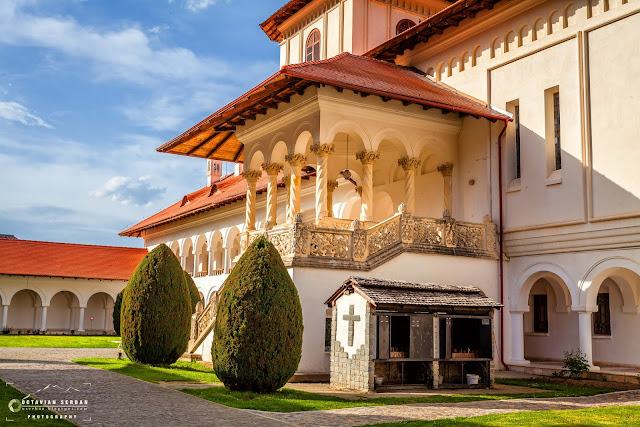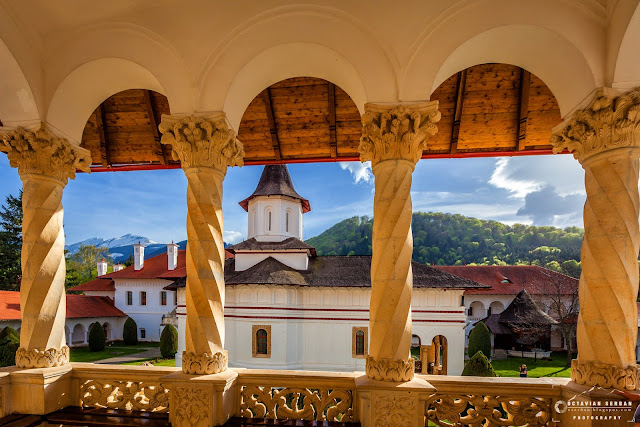Tuesday, May 16, 2017
Monday, May 15, 2017
Brancoveanu Monastery...
The “Brancoveanu” Monastery – Sambata de Sus – located on the valley of Sambata river- is famous for being a place of recovery, comfort and spiritual balm for visitors who halt or pray in this sacred dwelling.
The history of Brâncoveanu Monastery started in the 17th century, when Preda Brâncoveanu erected on Sambata Valley the first church built in wood. On its place, around the year 1696, Constantin Brâncoveanu, the ruler of Wallachia (1688 – 1714), re-built a monastery in stone, in order to strengthen and save the Romanian Orthodoxy from the danger of Catholicism, which appeared when Transylvania was ruled by the Habsburgs (1683). In 1785 the monastery was partially demolished by the order of general Bukow from Vienna All the cells were completely destroyed, the church became a ruin and the monks were driven away. Throughout the 140 years since the destruction there had been many people who tried to restore it such as Metropolitan Bishop Andrei Saguna, Bishop Ilarie Puscariu, nun Maria Boros and so on, but with no results. The honor of becoming the second founder of the Brâncoveanu Monastery was given to Metropolitan Nicolae Balan, who started the restoration work in the 1926. Its consecration took place in 1946 , after the war (that is why the precincts were not rebuilt).
The history of Brâncoveanu Monastery started in the 17th century, when Preda Brâncoveanu erected on Sambata Valley the first church built in wood. On its place, around the year 1696, Constantin Brâncoveanu, the ruler of Wallachia (1688 – 1714), re-built a monastery in stone, in order to strengthen and save the Romanian Orthodoxy from the danger of Catholicism, which appeared when Transylvania was ruled by the Habsburgs (1683). In 1785 the monastery was partially demolished by the order of general Bukow from Vienna All the cells were completely destroyed, the church became a ruin and the monks were driven away. Throughout the 140 years since the destruction there had been many people who tried to restore it such as Metropolitan Bishop Andrei Saguna, Bishop Ilarie Puscariu, nun Maria Boros and so on, but with no results. The honor of becoming the second founder of the Brâncoveanu Monastery was given to Metropolitan Nicolae Balan, who started the restoration work in the 1926. Its consecration took place in 1946 , after the war (that is why the precincts were not rebuilt).
The architectural style fits entirely Brâncoveanu style, which emerged in Wallachia at the end of the 17th century and the beginning of the 18th century. Stones decorate the windows and the door frames and I took real interest in observing the front entrance door, the sculptured pillars and the stone panels of the church which add a special beauty to the monastery.
The steeple is octagonal outside and cylindrical inside. The interior is divided into: altar, nave, narthex and porch and it is quite common to the churches built during Brâncoveanu’s time. The painting of the porch is entirely new and includes scenes from the Old Testament. The entrance from the porch to the narthex is through a thick oak door, framed by sculptured stone.
On the West-side of the narthex, where the Holy Virgin is painted, one can see the painting of Brâncoveanu’s founders. The monastery houses five bells cast in Vienna, very well harmonized, electrically rung nowadays and weighing more than 2,000 Kgs.
The precincts which have been rebuilt are quadrilateral, also in a Brâncoveanu style. Three stone-carved towers adorn the precincts both on the inside and on the outside. On the ground floor of the Northern buildings there are the abbey and the cells for the monks. On the first floor there is a steeple and a new monumental and spacious church. The ground floor of the Southern buildings comprises a large refectory, the kitchens and the cells and on the first floor there is a large library. http://www.brasovtravelguide.ro/brasov/surroundings/brancoveanu-monastery-sambata-de-sus/
Subscribe to:
Posts (Atom)





















































